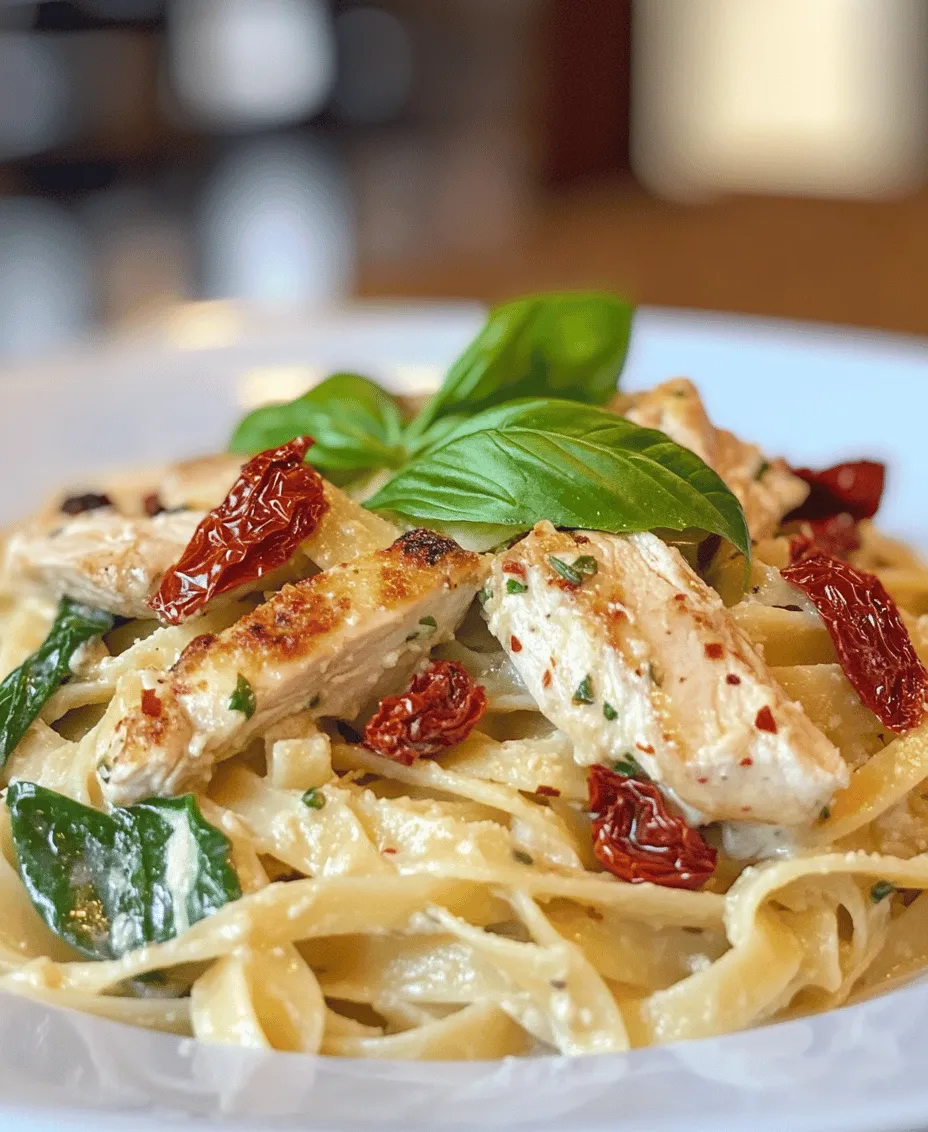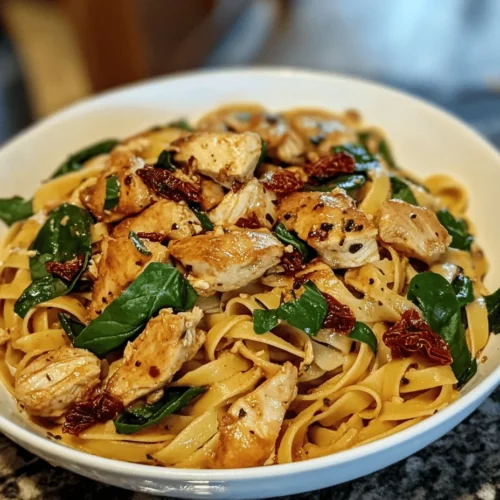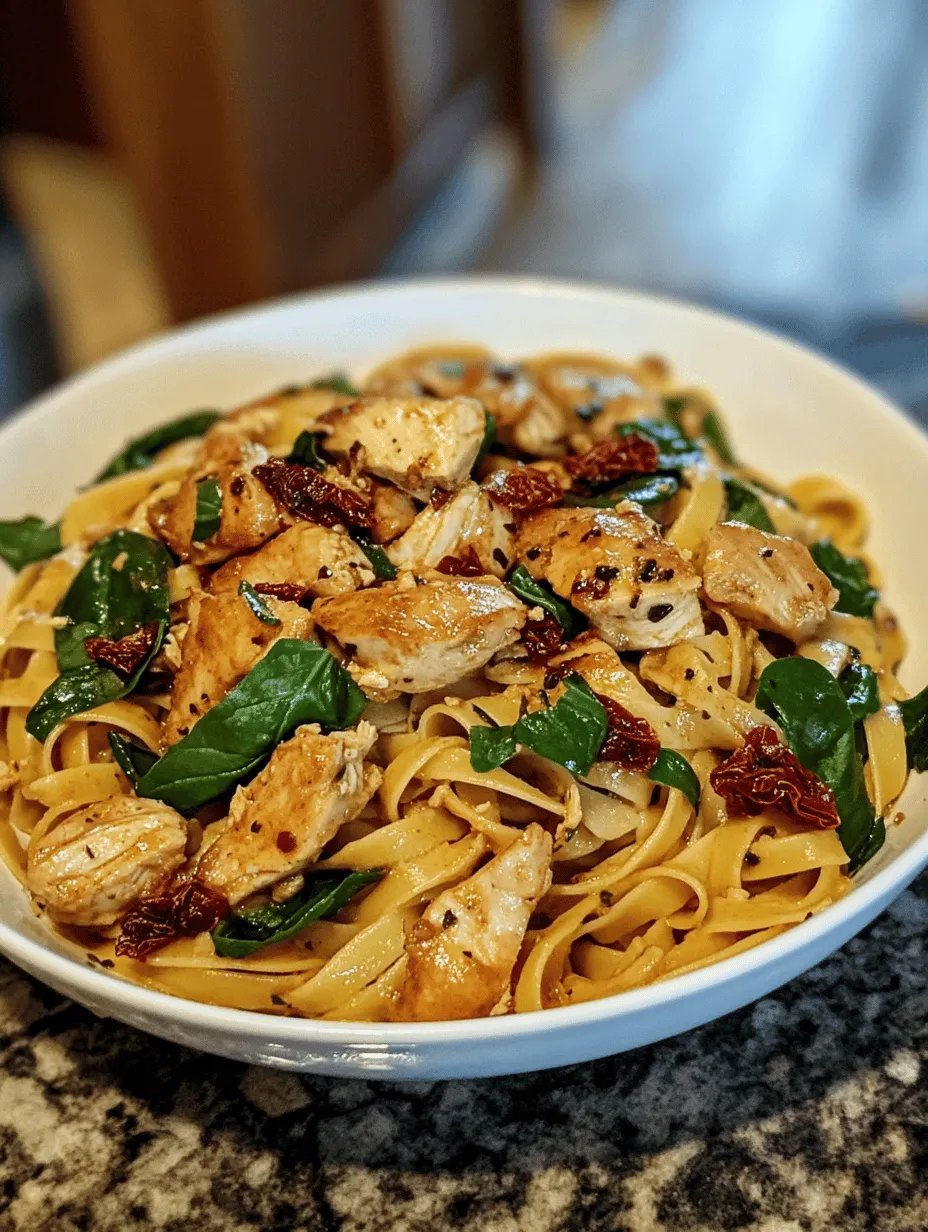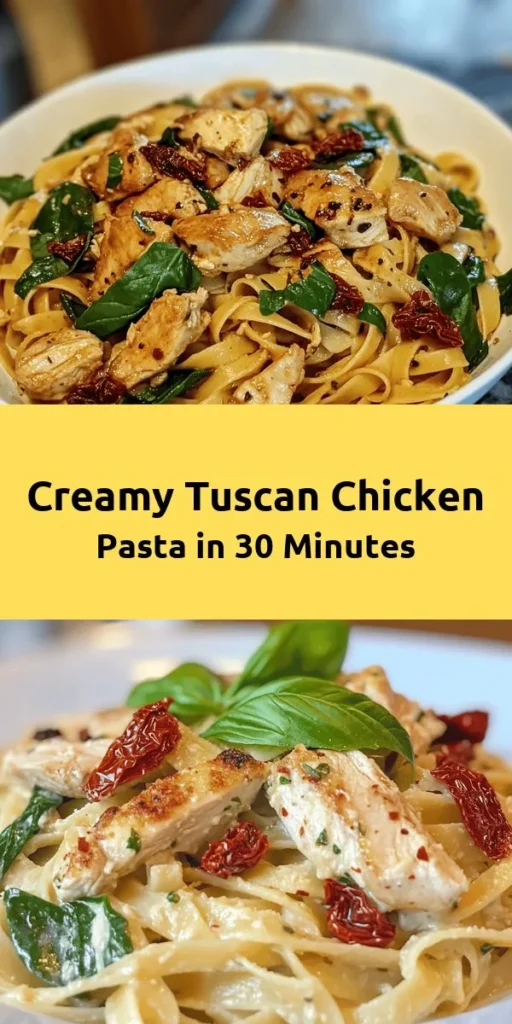When craving a dish that encapsulates the heart and soul of Italian cuisine, Tuscan Chicken Pasta emerges as a delectable choice. This creamy, rich pasta dish transports you to the sun-kissed hills of Tuscany with every bite, featuring a harmonious blend of flavors that make it perfect for both casual weeknight dinners and special occasions. The combination of tender chicken, vibrant sun-dried tomatoes, and fresh spinach enveloped in a luscious sauce makes this recipe a go-to for anyone looking to impress family and friends while enjoying the comforts of home cooking.
Tuscan cuisine is renowned for its rustic, wholesome ingredients that reflect the region’s agricultural heritage. With this Tuscan Chicken Pasta, we embrace this philosophy by utilizing fresh produce and high-quality pantry staples that not only enhance flavor but also offer a variety of nutritional benefits. As you embark on this culinary journey, you’ll be delighted to discover how simple ingredients can come together to create something extraordinary.
Understanding the Ingredients
To truly appreciate the beauty of Tuscan Chicken Pasta, it’s essential to understand the role of each ingredient. Here’s a closer look at what makes this dish so special:
Fettuccine Pasta
Fettuccine is a popular choice for creamy pasta dishes due to its wide, flat shape, which allows it to capture and hold sauces beautifully. The texture of fettuccine complements the rich cream sauce, creating a satisfying mouthfeel that elevates the overall dining experience. While you can substitute with other pasta shapes like penne or farfalle, fettuccine’s ability to cling to the sauce makes it the ideal candidate for this dish.
Chicken Breasts
Boneless, skinless chicken breasts are the star protein in this recipe. They are not only easy to cook but also versatile and lean, making them a healthy choice for a variety of meals. When prepared correctly, chicken breasts can be juicy and full of flavor. In this dish, they are sautéed until golden brown, allowing them to develop a flavorful crust while remaining tender and moist on the inside.
Olive Oil
Using high-quality olive oil is essential in Tuscan cooking. This heart-healthy fat is rich in monounsaturated fats and antioxidants, making it a staple in Mediterranean diets. In the preparation of Tuscan Chicken Pasta, olive oil is used for sautéing the chicken and aromatics, infusing the dish with its distinct flavor. It also helps in creating a smooth sauce that coats the pasta beautifully.
Garlic and Italian Herbs
Garlic is a key aromatic that enhances the flavor profile of this dish, adding depth and warmth. It pairs wonderfully with Italian herbs like basil, oregano, and thyme, which are often found in Tuscan recipes. These herbs not only contribute to the dish’s aromatic qualities but also add fresh, earthy notes that balance the richness of the cream sauce.
Sun-Dried Tomatoes
Sun-dried tomatoes are a game changer in this recipe. Their concentrated flavor adds a tangy sweetness that complements the creamy sauce and savory chicken. They provide a burst of color and texture, making each bite a delightful experience. You can find sun-dried tomatoes packed in oil or dry; either works well, but be sure to chop them before adding them to the dish for even distribution.
Fresh Spinach
Incorporating fresh spinach not only enhances the dish’s visual appeal with its vibrant green color, but it also brings an array of nutritional benefits. Spinach is rich in vitamins A, C, and K, as well as iron and fiber. When wilted into the creamy sauce, it adds a touch of freshness and a mild earthy flavor that balances the richness of the dish.
Heavy Cream and Parmesan Cheese
The foundation of the creamy sauce lies in heavy cream and grated Parmesan cheese. Heavy cream provides a luxurious texture, transforming the dish into a comforting delight. When combined with Parmesan cheese, the sauce thickens and becomes velvety, enveloping each strand of fettuccine in a rich, cheesy embrace. This duo is key to achieving the indulgent creaminess that defines Tuscan Chicken Pasta.
Garnishes
To elevate the dish further, garnishing with fresh basil adds a burst of aroma and freshness, while optional red pepper flakes introduce a hint of heat. These finishing touches not only enhance the visual appeal but also add layers of flavor that make the dish truly unforgettable.
Preparation Steps for Tuscan Chicken Pasta
Now that we’ve explored the essential ingredients, it’s time to prepare this mouthwatering Tuscan Chicken Pasta. Follow these clear, step-by-step instructions to create a dish that will impress everyone at your table.
Step 1: Cook the Fettuccine
Begin by bringing a large pot of salted water to a boil. Once the water is at a rolling boil, add the fettuccine pasta and cook according to the package instructions until al dente. This usually takes around 8-10 minutes. Be sure to stir occasionally to prevent the pasta from sticking together. Once cooked, reserve about a cup of the pasta cooking water, then drain the rest and set it aside.
Step 2: Sauté the Chicken
While the pasta cooks, heat a tablespoon of olive oil in a large skillet over medium-high heat. Season the boneless, skinless chicken breasts with salt and pepper on both sides. When the oil is hot, carefully place the chicken in the skillet. Sauté the chicken for about 6-7 minutes on each side or until it’s golden brown and cooked through (the internal temperature should reach 165°F). Once cooked, remove the chicken from the skillet and let it rest for a few minutes before slicing it into bite-sized pieces.
Step 3: Build the Flavorful Base
In the same skillet, add another tablespoon of olive oil if needed. Reduce the heat to medium and add minced garlic. Sauté for about 30 seconds, or until fragrant, being careful not to burn it. Next, add the chopped sun-dried tomatoes and Italian herbs, stirring to combine and cook for another minute.
Step 4: Create the Creamy Sauce
Pour in the heavy cream and bring the mixture to a gentle simmer. Stir continuously, allowing the cream to thicken slightly. As it simmers, gradually add the grated Parmesan cheese, stirring until it melts into the sauce. If the sauce is too thick, you can add a little reserved pasta water to reach your desired consistency.
Step 5: Add Spinach and Chicken
Once the sauce is creamy and smooth, fold in the fresh spinach and sliced chicken. Cook for an additional 2-3 minutes, allowing the spinach to wilt and the chicken to heat through. Taste the sauce and adjust seasoning with more salt, pepper, or red pepper flakes if desired.
Step 6: Combine with Fettuccine
Finally, add the cooked fettuccine to the skillet, gently tossing it in the creamy sauce until fully coated. If needed, you can add more reserved pasta water to help the sauce adhere to the noodles.
Step 7: Serve and Garnish
Plate the Tuscan Chicken Pasta immediately, garnishing each serving with fresh basil and more grated Parmesan cheese. Enjoy this rich, comforting dish that captures the essence of Tuscany in every bite.
With these detailed steps, you’re well on your way to mastering the art of Tuscan Chicken Pasta. The combination of flavors and textures will transport you to Italy, making this dish a delightful addition to your home cooking repertoire. Stay tuned for more tips and techniques to perfect your creation and impress your guests!

Cooking the Fettuccine
The foundation of any great pasta dish lies in the proper cooking of the pasta. For Tuscan Chicken Pasta, fettuccine is the star, and cooking it to the perfect al dente texture is crucial. Al dente refers to pasta that is firm to the bite, providing the ideal mouthfeel and allowing it to hold up well when combined with the creamy sauce. To achieve this, bring a large pot of salted water to a rolling boil before adding the fettuccine. Stir the pasta to prevent sticking and follow the package instructions for cooking time, usually around 8 to 10 minutes.
An essential tip is to reserve about a cup of the pasta cooking water before draining. This starchy water is a key ingredient in adjusting the sauce’s consistency later, ensuring it clings beautifully to the pasta.
Sautéing the Chicken
Perfectly sautéed chicken is the cornerstone of this dish. Start by patting the chicken breasts dry with paper towels, which helps achieve a golden-brown crust. Season both sides generously with salt, pepper, and any Italian seasoning you prefer. Heat a tablespoon of olive oil in a large skillet over medium-high heat. When the oil is shimmering, carefully add the chicken breasts.
Cook the chicken undisturbed for about 5-7 minutes on one side until it develops a golden crust. Flip the chicken and continue cooking for another 5-7 minutes or until the internal temperature reaches 165°F (75°C). If you have thick chicken breasts, you may need to lower the heat to ensure it cooks through without burning the exterior. Once cooked, remove the chicken from the skillet and let it rest before slicing it into strips. This resting period allows the juices to redistribute, keeping the chicken moist and flavorful.
Aromatic Sautéing
With the chicken cooked, it’s time to build flavor in the skillet. Add another tablespoon of olive oil if needed, then toss in minced garlic and sauté until fragrant, about 30 seconds. Be careful not to burn the garlic, as it can turn bitter quickly. This is the moment to add fresh herbs, such as chopped parsley or basil, which will release their oils and enhance the overall flavor profile.
The timing here is key; once the garlic becomes golden and aromatic, it’s time to move on to the next step. This quick sautéing infuses the oil with a rich flavor, setting the stage for the rest of the ingredients to shine in the dish.
Incorporating Vegetables
Now, it’s time to bring in the sun-dried tomatoes and spinach. The sun-dried tomatoes add a delightful sweetness and tang, while the spinach contributes a fresh, vibrant element. If using jarred sun-dried tomatoes, ensure they are well-drained and chopped into bite-sized pieces. Add them to the skillet first, stirring for about a minute to warm them through and release their flavor.
Next, add the fresh spinach. Stir continuously as it wilts down in the heat of the skillet, which should take just a couple of minutes. It’s important to maintain the spinach’s bright green color and tender texture, so avoid overcooking it. Once wilted, you’re ready to move on to creating the creamy sauce.
Creating the Cream Sauce
For a rich and creamy sauce, you will incorporate heavy cream and Parmesan cheese. Pour the heavy cream into the skillet, stirring to combine it with the sautéed vegetables and aromatics. Allow the cream to simmer gently, which will thicken the sauce slightly.
Add in freshly grated Parmesan cheese gradually, stirring continuously until the cheese melts and the sauce becomes creamy. If the sauce is too thick, gradually add the reserved pasta water, a little at a time, until you reach your desired consistency. This technique ensures the sauce adheres beautifully to the fettuccine. Taste and adjust seasoning with salt and pepper if necessary.
Combining Ingredients
With the sauce ready, it’s time to bring everything together. Add the cooked fettuccine directly into the skillet, tossing it gently with the sauce to coat each strand thoroughly. If you find the pasta is sticking together, add a bit more reserved pasta water to loosen it.
Finally, return the sliced chicken to the skillet, nestling it among the pasta and sauce. This not only warms the chicken but allows its flavors to meld with the rest of the dish. Toss everything together for a minute or two to ensure even coating and to warm through.
Serving Suggestions and Pairings
Presentation is key when it comes to serving Tuscan Chicken Pasta. A well-plated dish enhances the dining experience and makes the meal feel special.
Plate Presentation
For an elegant presentation, twirl a generous portion of the fettuccine onto a plate, ensuring the chicken is visible on top. Drizzle a bit of the creamy sauce over the chicken and pasta for a glossy finish. Garnish with freshly torn basil leaves and a sprinkle of grated Parmesan for a pop of color and added flavor. A light dusting of cracked black pepper enhances the visual appeal as well.
Wine Pairings
When it comes to pairing wine with your Tuscan Chicken Pasta, consider a light Italian white wine such as Pinot Grigio or a medium-bodied red like Chianti. These wines complement the creamy sauce and enhance the savory flavors of the dish, making for a well-rounded dining experience.
Side Dishes
To complete your meal, consider serving garlic bread or a fresh garden salad alongside your Tuscan Chicken Pasta. Garlic bread adds a crunchy texture and is perfect for soaking up any leftover sauce. A simple salad with mixed greens, cherry tomatoes, and a light vinaigrette provides a refreshing contrast to the rich pasta.
Nutritional Information
Understanding the nutritional content of your meal is essential, especially for those who are health-conscious. A standard serving of Tuscan Chicken Pasta typically contains approximately:
– Calories: 600-700 kcal
– Protein: 35-40g
– Carbohydrates: 70-80g
– Fats: 25-30g
This dish is rich in protein from the chicken and provides carbohydrates from the fettuccine, making it a satisfying option. For those watching their intake, consider using whole wheat fettuccine or substituting heavy cream with a lighter alternative such as half-and-half or a dairy-free cream.
Conclusion
Tuscan Chicken Pasta is more than just a meal; it embodies the essence of Italian cuisine, showcasing fresh ingredients and rich flavors that transport you to the heart of Tuscany. The process of preparing this dish—cooking the pasta to perfection, sautéing the chicken until golden, and creating a creamy sauce—offers a rewarding culinary experience that fills your kitchen with mouthwatering aromas.
This dish is perfect for both casual family dinners and special occasions alike, inviting everyone to gather around the table. Embrace the flavors of Tuscany in your own home, and enjoy the comfort and warmth that comes from sharing a lovingly prepared meal. With each bite of Tuscan Chicken Pasta, you’ll find a delightful blend of textures and tastes that will keep you coming back for more. So, roll up your sleeves and bring this comforting classic to your dinner table, where it is sure to become a beloved staple in your cooking repertoire.



